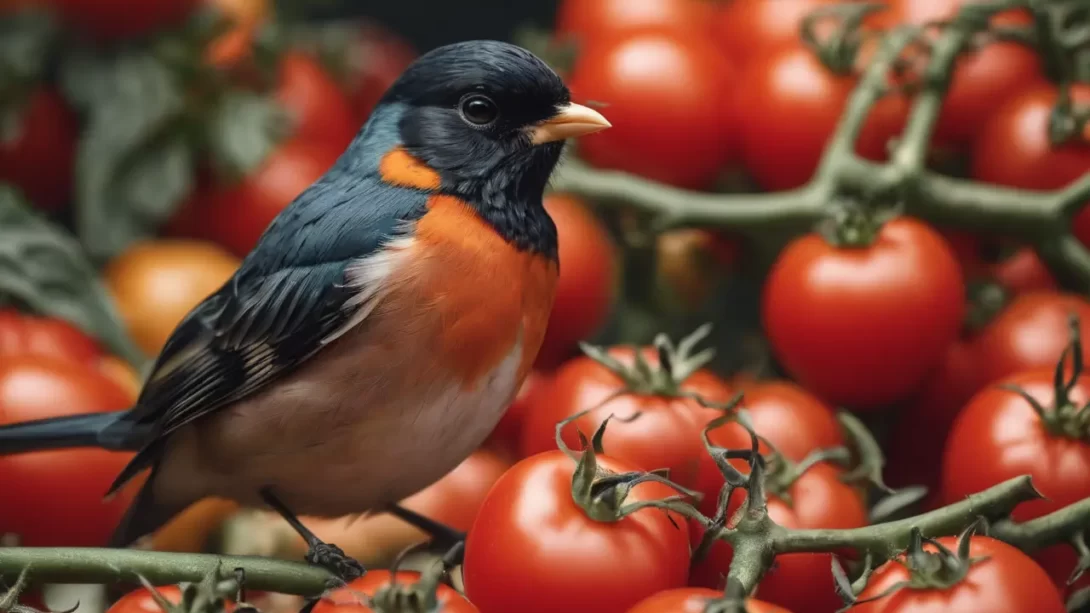The question of whether birds can safely eat tomatoes is a common one among bird enthusiasts and pet owners. Tomatoes, a staple in human diets, are known for their nutritional value and versatility. This article aims to explore the safety and potential benefits of incorporating tomatoes into a bird’s diet, providing insights for those who care for and enjoy watching birds.
Tomatoes
Tomatoes are a widely consumed fruit, often mistaken for a vegetable, and come in various types, including cherry, beefsteak, and heirloom tomatoes. They are known for their rich content in vitamins, minerals, and antioxidants, making them a potentially beneficial food for birds. However, the acidity and sugar content of tomatoes, especially in their unripe form, raise questions about their suitability for avian diets.
A critical distinction to make is between ripe and unripe tomatoes. Ripe tomatoes have lower levels of solanine, a substance that can be toxic to birds, while unripe tomatoes, with their greenish hue, contain higher solanine levels. This distinction is essential when considering tomatoes as a food source for birds.
Nutritional Benefits of Tomatoes for Birds
Tomatoes can offer several nutritional benefits to birds. They are rich in vitamins A and C, both of which are important for a bird’s immune system and overall health. Tomatoes also contain antioxidants like lycopene, known for its health-protective properties. These nutrients can contribute positively to feather health, vision, and the general well-being of birds.
However, the benefits of tomatoes for birds depend on several factors, including the bird’s species, overall diet, and health status. Not all birds may find tomatoes appealing, and for some, the high acidity might not be suitable. Understanding the specific dietary needs and preferences of different bird species is crucial in determining whether tomatoes should be included in their diet.
Risks Associated with Tomatoes for Birds
While tomatoes can be nutritious, there are potential risks involved when feeding them to birds. The primary concern lies in the acidity of tomatoes, which can be harsh on a bird’s digestive system. This is especially true for smaller bird species or those with sensitive digestive tracts. Additionally, the stems and leaves of the tomato plant contain solanine, a toxic substance that can be harmful to birds if ingested.
Unripe tomatoes, which are higher in solanine, pose a greater risk than ripe ones. Ingesting unripe tomatoes or parts of the tomato plant can lead to symptoms such as gastrointestinal distress, lethargy, and in severe cases, more serious health complications.
Safe Ways to Feed Tomatoes to Birds
If you choose to feed tomatoes to birds, it’s important to do so safely and responsibly. Here are some guidelines to follow:
- Use Only Ripe Tomatoes: Ensure the tomatoes are fully ripe before offering them to birds. Ripe tomatoes have lower acidity and solanine levels, making them safer for bird consumption.
- Preparation: Wash the tomatoes thoroughly to remove any pesticides or chemicals. Cutting the tomatoes into small, manageable pieces can make it easier for birds to eat.
- Moderation: Offer tomatoes in moderation as part of a varied diet. They should not be the primary food source but rather an occasional treat.
- Remove Plant Parts: Ensure that no stems or leaves are attached to the tomatoes, as these parts are toxic to birds.
- Monitor Bird’s Reaction: Observe how the bird reacts to the tomatoes. If there are signs of digestive upset or refusal to eat, it’s best to avoid offering tomatoes in the future.
Alternatives to Tomatoes for Bird Diets
For bird owners or enthusiasts looking to provide a varied and balanced diet, there are numerous alternatives to tomatoes. Fruits like apples, berries, and melons can be great options, offering vitamins and hydration. Vegetables such as carrots, peas, and cooked sweet potatoes are also suitable and provide essential nutrients. It’s important to research and understand which foods are safe and beneficial for the specific species of bird you are feeding.
Conclusion
In conclusion, while tomatoes can be a nutritious treat for birds, they should be offered with caution. Fully ripe tomatoes, free from stems and leaves, can be included in a bird’s diet in moderation. However, due to their acidity and the potential presence of solanine, particularly in unripe tomatoes and plant parts, it is essential to be mindful of the type and quantity of tomatoes fed to birds.
The safety and nutritional value of tomatoes for birds depend on various factors, including the bird’s species, overall diet, and individual health. As bird enthusiasts or pet owners, it is crucial to ensure that the dietary needs of the specific bird species are met. This often involves providing a diverse range of fruits and vegetables, along with their regular diet, to ensure a balanced intake of nutrients.
Feeding birds like a hobby or as part of pet care should always be approached with research and understanding. Each bird species has its unique dietary requirements and preferences. While tomatoes can be a part of this diet, they should not replace a bird’s primary food sources.
This exploration into the suitability of tomatoes for birds underscores the broader theme of responsible bird feeding and care. Whether you’re a backyard birdwatcher or a pet bird owner, understanding what foods are safe and beneficial is key to supporting the health and happiness of our feathered friends. By doing so, we not only enrich the lives of the birds we feed but also contribute positively to the delicate balance of our local ecosystems.




